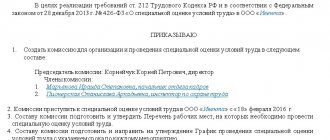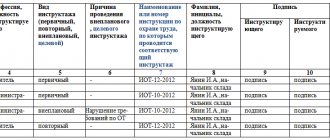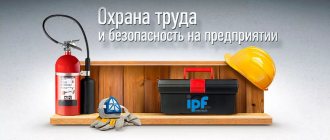An employee's responsibilities in the field of labor protection (OHS) are regulated by the Labor Code of the Russian Federation, a number of federal laws and industry-specific regulations. Strict compliance with these requirements is an important part of the labor functions for each employee, regardless of his position and field of activity. Compliance with occupational safety requirements reduces the risk of situations that could pose a threat to the life and health of the employee and the people around him. This article will discuss what the responsibilities of an occupational safety and health worker are and what the liability will be for failure to fulfill them.
Occupational safety and health at the enterprise: main points
Labor safety rules were not just invented by legislators. They provide protection to employees from accidents, and in the event of unforeseen incidents that cause injuries at work, they guarantee that the employee will receive some kind of compensation.
For each type of work, the Labor Code defines its own requirements. Administrative employees are required to monitor their compliance, just like compliance with sanitary standards and rules. Performers directly involved in production processes must strictly follow the developed labor protection instructions.
Each employee must contribute to the creation of a safe production and, if any malfunctions are detected in the operation of equipment or disregard for labor safety standards on the part of other people, he is obliged to notify his employer about this.
This will allow you to avoid traumatic situations and take timely measures to ensure their further prevention.
How to organize a labor safety management system in an organization?
Commentary on Article 214 of the Labor Code of the Russian Federation
1. Among the main duties of the Labor Code assigned to the employee are the obligations to comply with labor protection and labor safety requirements, to immediately inform the employer or immediate supervisor about the occurrence of a situation that poses a threat to the life and health of people (Article 21).
The commented article provides for a wider range of employee responsibilities in the field of labor protection.
Since the concept of “employee” covers not only persons in blue-collar professions, but also managers, specialists and other employees, the responsibilities listed in the commented article apply to all categories of workers and are assigned both to workers performing organizational and administrative functions, and to workers engaged in production activities. The scope of responsibilities of the corresponding category of employees to comply with labor protection requirements is established depending on their legal status. Thus, employees performing organizational and administrative functions are required to comply with state regulatory requirements contained in federal laws and laws of the constituent entities of the Russian Federation, intersectoral and sectoral rules on labor protection, intersectoral standard and sectoral standard instructions on labor protection, safety rules, technical regulations, sanitary norms and rules. These rules contain the requirements for production premises and production sites (for processes performed outside production premises); requirements regulating permissible levels of hazardous and harmful production factors in production premises, on sites - for processes carried out outside production premises and in workplaces, as well as requirements for lighting, temperature, humidity and other production factors.
Labor protection rules also include requirements for the organization of work and other operations that affect the safety of workers; requirements for production equipment and its placement; requirements for raw materials, blanks, semi-finished products, methods of their storage and transportation; safety requirements for the organization of production (technological) processes (including fire and explosion safety requirements), for control and management systems of technological processes that ensure the protection of workers, for measures to protect workers from the effects of hazardous and harmful production factors arising in emergency situations, etc. In addition, persons performing organizational and administrative functions are charged with monitoring compliance with labor safety instructions by employees subordinate to them. The specific responsibilities of persons performing organizational and administrative functions in the field of labor protection are defined in job descriptions.
Workers engaged in production activities are required to comply with labor protection instructions developed based on their professions or types of work performed on the basis of inter-industry or industry standard labor protection instructions.
These instructions on labor protection for workers contain:
— safety requirements before starting work (the procedure for preparing the workplace, personal protective equipment; the procedure for checking the serviceability of equipment, devices and tools, fences, alarms, blocking and other devices, protective grounding, ventilation, local lighting, etc.; the procedure for checking the initial materials (blanks, semi-finished products); the procedure for receiving and transferring shifts in the case of a continuous technological process and equipment operation, etc.);
— safety requirements during work (methods and techniques for the safe performance of work, the use of technological equipment, vehicles, lifting mechanisms, devices and tools; requirements for the safe handling of starting materials (raw materials, workpieces, semi-finished products); instructions for the safe maintenance of the workplace; actions aimed at preventing emergency situations; requirements for the use of personal protective equipment for workers, etc.);
— safety requirements upon completion of work (procedure for shutting down, stopping, disassembling, cleaning and lubrication of equipment, fixtures, machines, mechanisms and equipment; procedure for removing waste generated during production activities; requirements for maintaining personal hygiene; procedure for notifying the work manager about deficiencies affecting on labor safety discovered during work, etc.);
— safety requirements in emergency situations (stop work, turn off power from faulty equipment (equipment, stand), if necessary, fence off the dangerous place and immediately report the incident to the work manager and then follow his instructions to prevent accidents or eliminate the emergency situation that has arisen , act in accordance with the approved emergency response plan, etc.). If a fire occurs, you must: immediately notify the fire department, indicating the exact location of the fire; inform the work manager; notify others and, if necessary, remove people from the danger zone; begin to extinguish the fire using primary fire extinguishing agents; organize a meeting of the fire brigade.
Managers, specialists and other employees performing their work functions under conditions of exposure to harmful or dangerous factors or in cases where their work requires the use of methods and techniques for the safe performance of work, appropriate handling of machines, mechanisms, equipment, must also comply with safety requirements, established by labor protection instructions.
2. Along with managers and other employees, employees directly involved in production activities should also contribute to the creation of safe working conditions. Consolidation in the commented article of the duties of workers to correctly use personal and collective protective equipment, undergo training in safe methods and techniques for performing work and providing first aid to victims at work, undergo mandatory medical examinations, immediately notify their immediate or superior manager about any situation that threatens life and health people, etc. is not only aimed at reducing the risk of situations that threaten the life and health of people, but also allows the employer to take timely measures to prevent them.
3. Certain categories of workers are assigned by law additional responsibilities in the field of labor protection. So, for example, in accordance with paragraph 2 of Art. 9 of the Law on Industrial Safety of Hazardous Production Facilities, employees of a hazardous production facility are required to suspend work in the prescribed manner in the event of an accident or incident at a hazardous production facility, and to participate in the work to localize the accident at a hazardous production facility.
Federal Law dated 03/08/2011 N 35-FZ “Charter on discipline of employees of organizations operating particularly radiation-hazardous and nuclear-hazardous production and facilities in the field of nuclear energy use” establishes the following responsibilities of employees of operating organizations: to be constantly prepared to prevent and eliminate emergency situations, preventing the development of an accident or eliminating its consequences, acting in the event of an emergency in accordance with the requirements of emergency instructions and in accordance with the emergency response plan; arrive immediately at work when called by the employer or a person authorized by him to prevent the development of an accident or eliminate its consequences; do not leave your workplace without permission; promptly inform your immediate supervisor or superior manager in the order of subordination about the reasons and conditions under which it is prohibited to continue work in the field of atomic energy use (presence of breastfed children, determination of disability, presence of medical contraindications), etc. (Article 2).
4. For non-fulfillment or improper fulfillment of the duties enshrined in the commented article, employees may be subject to disciplinary liability (see commentary to Article 419).
Collective and individual protective equipment
In many industries, work is impossible without personal protective equipment and every employee must be able to use them. In order to avoid the harmful effects of hazardous factors, personnel are required to use various devices to protect the head, skin, respiratory organs, eyes, hands, and feet. When carrying out work at height, it is also necessary to use certain protective equipment.
Is certification of occupational safety and health work in an organization?
Personal protection
All personal protective equipment is divided into three categories:
- special shoes;
- special clothing;
- other means.
If everything is clear with protective clothing and safety footwear, then a little more detail should be said about other protective equipment . These include:
- for hands: gaiters, gloves, mittens;
- for eyes: special safety glasses;
- for hearing organs: headphones, earplugs;
- for the face and head: helmets, shields, hard hats;
- for the respiratory system: gas masks, cotton-gauze bandages, respirators;
- for skin: cleansers and special creams;
- for high-altitude work - cables and safety belts.
How to create a training program for occupational safety ?
Collective defense
If a group of people works in dangerous conditions, whether natural or man-made, then they must be provided with collective protection. What it is? Collective protection means:
- devices for normalizing lighting;
- devices for improving the air environment;
- protective equipment against hazardous production factors.
In cases where, by the time they began performing their job duties, employees were not provided with working protective equipment, as well as, if necessary, special clothing and safety footwear, they have the right to refuse the functions assigned to them. In addition, all employees using protective equipment must be instructed in advance on how to use them correctly, and training must be both theoretical and practical.
Training in safe work methods and first aid for victims
One type of obligation is mandatory training in safety rules and regulations. In organizations where hazardous or harmful factors are present, there is also an obligation for specialists to undergo first aid training. This type of training should take place in medical institutions and take into account the specifics of hazardous production factors that employees of the organization may encounter.
Note! Such an obligation is established in relation to a certain category of persons by order of the organization.
Types of obligations assigned to specialists
Responsibilities of the employee to use protective equipment
Each employee who is legally familiar with labor safety rules and performs his or her work in conditions requiring the use of protective equipment is obliged to:
- use protective equipment throughout the entire work shift;
- use protective equipment as prescribed in the rules of their use;
- inform the employer about all breakdowns and malfunctions of protective devices, and this must be done in a timely manner;
- use protective equipment with care;
- re-train on how to use the protection if facts of its incorrect use are discovered or the modification is updated.
Normative base
The dominant regulatory framework in this area is labor legislation. It is the labor code that establishes the worker’s right to work. Responsibility for violations, the obligation to fulfill the legal requirements of management and the condition of compliance with the basic norm of behavior in the organization.
A set of actions carried out to ensure safety
Also, general control in this area is ensured by issuing by-laws of industry legislation, primarily in the industrial sector of the economy. These acts specify the rules of law in the industry and take into account its specifics when distributing responsibilities among persons in legal relations. A regulatory act may also establish a certain measure of liability for personnel in case of violation of specific obligations not regulated by federal laws.
As a result, the answer to the question of what is an employee’s responsibilities in the field of labor protection is an array of legally established requirements that the employee must strictly comply with. Otherwise, such an employee will be subject to various types of penalties, including criminal liability.
Occupational safety: briefing
Before starting work, the employee is required to undergo occupational safety training. This applies to all newly hired people in the organization - they need to be briefly familiarized with the conditions and rules of production processes. This work with them should be carried out either by a personnel officer or a labor protection specialist.
This procedure is performed in a specially designated room using all necessary aids and protective equipment.
In addition to general briefing, if work conditions require it, the labor protection specialist must also conduct briefing directly at the workplace, and subsequently periodically conduct unscheduled , targeted and repeated .
The briefing includes:
- announcement of the law and instructions on labor protection;
- warning the employee about existing hazardous factors at work;
- training in safe work performance;
- first aid training in cases of personnel injury.
After completing the training, the new employee is required to sign the appropriate document confirming familiarization with the rules and regulations in force at the enterprise.
Important! If, while working at the same enterprise, an employee is transferred for some reason from one area of work to another, he is required to undergo instruction and internship again, but in accordance with the new profile.
Responsibility for failure to comply with labor safety standards and regulations
Persons who do not fulfill basic responsibilities in the field of labor protection may be subject to disciplinary, and in some cases administrative and even criminal liability.
Disciplinary
Failure by employees to fulfill their responsibilities in the field of occupational safety can be considered a violation of the terms of the employment contract. In accordance with Art. 192 of the Labor Code of the Russian Federation, penalties in the form of a reprimand or reprimand can be applied to an unscrupulous employee.
If the actions of an employee who does not comply with occupational safety standards lead to serious consequences, such as an accident, and this is recorded by the commission, he can be dismissed on the basis of Art. 81 of the Labor Code of the Russian Federation (subparagraph “e” of paragraph 6 of the article).
Administrative
The procedure for bringing to administrative responsibility is regulated by Art. 5.27 Code of Administrative Offenses of the Russian Federation. In accordance with the provisions of this article, officials who have violated or committed violations of labor legislation (including in terms of labor safety) may be punished financially - with a fine in the amount of 1,000 to 5,000 rubles. for the first violation, and from 20,000 to 30,000 rubles for a repeated violation.
A legal entity may also be fined in the amount of 30,000-50,000 (for repeated violations 50,000-70,000) rubles.
Criminal
If violation of occupational safety requirements entails serious consequences (injury, death), then the person responsible for compliance with occupational safety standards may also be held criminally liable.
In this case, penalties, in accordance with Art. 143 of the Criminal Code of the Russian Federation, may be the following:
- in case of causing serious harm to health - a fine of up to 400,000 rubles or compulsory, forced labor, or imprisonment for up to 1 year;
- if death is caused by negligence - up to 4 (5 in the case of 2 or more deaths) years of imprisonment.
Imprisonment may be accompanied by a ban on holding certain positions for up to 3 years.
Responsibilities of the employee to warn management about emergency situations
Each employee of the enterprise in the event of an injury or manifestation of an occupational disease in himself or one of his colleagues is obliged to notify management about this. The same must be done if, during work, circumstances suddenly arise that threaten the health and lives of people.
If an injury occurs, the victim must be given first aid and immediately taken to the nearest medical center. In the event of a danger that threatens people or the production process, each employee must immediately stop performing his duties and report this to his immediate superiors.
Let's sum it up
Following labor safety rules is a vitally important point that must be observed at the enterprise. It is important to understand that if the list of requirements presented in the material is not met, production management has the right to apply disciplinary measures to the employee.
In the table below we consider the main responsibilities of employees in the field of labor protection.
Table 1. What responsibilities must be performed
| Comply with the presented labor protection requirements | Use security measures on an ongoing basis | Receive training in safe work methods, as well as first aid | Provide emergency notification | Go through medical examinations |
| 1. Comply with legal labor standards. 2. Follow sanitary rules. 3. Follow other rules applicable to work in a specific production facility. | 1. It is necessary to use personal protective equipment:
| 1. Get instructions. 2. Pass the theoretical knowledge test. 3. Apply knowledge in practice. | If potential hazards or altered conditions are detected, employees must be notified:
| Pass inspections:
|
In addition, compliance with the required legislative rules is reasonable not only from the point of view of avoiding punishment, but also from the point of view of preserving the own lives and health of employees, as well as their entire team.
Be careful with the requirements presented. Study them carefully. If some information from the briefing remains unclear to you, ask the employee responsible for conveying it to you to read all the instructions again.
Compliance with labor safety rules is the key to the health of production employees
What the employer and the safety department must do to ensure labor safety in the organization
When choosing measures, it is recommended to rely on Order of the Ministry of Labor of Russia dated March 1, 2012 No. 181n “On approval of the Standard List of measures annually implemented by the employer to improve working conditions and safety and reduce levels of occupational risks.”
In general, managers, together with service specialists, must adhere to the paragraphs of Art. 212 of the Labor Code of the Russian Federation, which establishes the following responsibilities:
- ensure safety during operation of equipment, buildings, tools and other things;
- issue personal protective equipment, disinfectants, etc.;
- create optimal working conditions at each workplace;
- check whether labor protection requirements are met by employees and managers;
- conduct a special assessment of working conditions;
- control the sanitary and medical care of workers, work and rest schedules;
- send workers for medical examinations and examinations;
- conduct labor safety briefings, send specialists to advanced training courses;
- follow the instructions of the GIT.
The list of events may be updated. If the company does not have financial difficulties, occupational safety at the enterprise may involve taking additional measures to maintain the health of employees. For example, it is possible to organize sanatorium-resort treatment at the expense of the employer, conduct extraordinary examinations in clinics, etc.
Basic rights and obligations of employees
Ensuring rights to labor protection
All employees have the right :
- to the territory and personal space to perform official duties;
- availability of insurance against unforeseen circumstances at the enterprise and occupational diseases established by federal legislation;
- receive information about the situation at your workplace from your boss, about possible health consequences, as well as ways to protect yourself from harmful and dangerous factors;
- not to perform work if there is a risk of life-threatening factors or a threat to his health until eliminated;
- gain knowledge of safe methods and techniques for performing duties;
- undergo retraining if the workplace was liquidated due to violations of labor protection;
- request an inspection of your workplace to ensure compliance with these requirements;
- contact any authorized body or organization with any question related to the topic of the right to labor protection;
- take part in resolving issues related to ensuring safe operating conditions, as well as investigate an accident or occupational disease that has occurred;
- maintain your position and average salary for the period of forced medical examination;
- receive guarantees and monetary payments accepted in accordance with this Code, an employment contract, agreement, local regulations, if his profession is associated with harmful or life-threatening conditions.
Find out additionally what rights an employee who has entered into an employment contract with an employer has.
Responsibilities of a working citizen
At the same time, each employee has a number of responsibilities that he must strictly fulfill. Workers must:
- comply with OT requirements;
- be able to use personal and collective protective equipment;
- undergo mandatory safety training, training in methods and techniques for performing job duties, undergo an internship upon hiring (if required by contract);
- immediately notify the employer about possible situations that pose a threat to the life and health of people, about accidents that have occurred at the enterprise, as well as about the appearance of the first signs of an incipient occupational disease;
- undergo routine medical examinations and a medical examination upon hiring (if required for the position).
Punishment for non-fulfillment and non-compliance with guarantees
If an employer does not fulfill its obligations to comply with labor safety standards, various types of sanctions for violations are applicable to it. Employers can be brought to various types of liability: material, administrative, disciplinary, civil and even criminal.
Information! Administrative punishment occurs both for illegal actions and for inaction of officials.
Criminal prosecution is brought for violation of regulatory labor safety requirements if this causes death or serious harm to the health of an employee. Such responsibility is borne by persons who, due to their official position, are entrusted with the responsibility to ensure the principles of security of activities.








